
FIFA International Soccer is a 1993 association football video game developed by EA Canada's Extended Play Productions team and published by Electronic Arts. The game was released for the Sega Mega Drive/Genesis console in December 1993 and ported to numerous other systems in 1994. It is the first game in the FIFA series.

FIFA 97 is a football simulation video game developed by EA Canada and published by Electronic Arts. It was released for PC on 24 June 1996 and versions for PlayStation, SNES, Mega Drive and Sega Saturn followed.
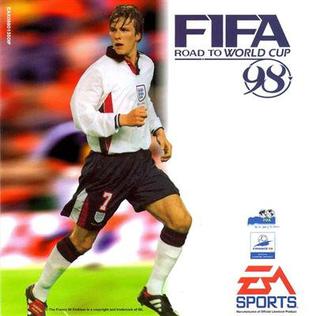
FIFA: Road to World Cup 98 is a football simulation video game developed by EA Canada and released by Electronic Arts in 1997. It is the fifth game in the FIFA series and the second to be in 3D on the fifth generation of video game consoles. A number of different players were featured on the cover, including David Beckham in the UK, Roy Lassiter in the United States, Mexico and Brazil, David Ginola in France, Raúl in Spain and Portugal, Paolo Maldini in Italy, and Andreas Möller in Germany. FIFA 98 was the last FIFA game released for the Sega Genesis, Sega Saturn and the Super Nintendo Entertainment System (SNES).
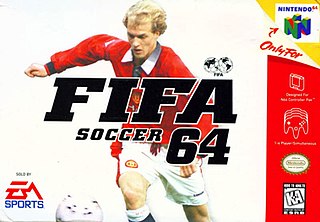
FIFA Soccer 64, known in Europe as FIFA 64 and in Japan as J. League Live 64, is an association football video game developed by EA Canada and published by Electronic Arts for the Nintendo 64. The cover features Manchester United midfielder Jordi Cruyff. The game garnered mixed reviews from critics upon release. Although its simulation was generally praised as realistic, reviewers critiqued the jerky animation, choppy frame-rates, unresponsive controls, and underwhelming usage of the Nintendo 64's capabilities. The Japanese version has officially licensed players and teams from Japan's J. League.

NBA 2K6 is a 2005 basketball simulation video game developed by Visual Concepts and published by 2K. It is the seventh installment in the NBA 2K franchise and the successor to ESPN NBA 2K5. It was released in 2005 for PlayStation 2, Xbox, and Xbox 360. Shaquille O'Neal of the Miami Heat is the cover athlete of the game. NBA 2K6 is the predecessor to NBA 2K7 in the NBA 2K series and is the first NBA 2K title to be released by 2K Sports. This is the first game in the series to be released for the Xbox 360.
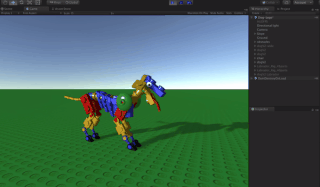
A procedural animation is a type of computer animation used to automatically generate animation in real-time to allow for a more diverse series of actions than would otherwise be tedious using predefined animations.

NBA 2K7 is a 2006 basketball simulation video game developed by Visual Concepts and published by 2K. It is the eighth installment in the NBA 2K franchise and the successor to NBA 2K6. It was released in 2006 for PlayStation 2, Xbox, and Xbox 360, and as a launch title for PlayStation 3. Shaquille O'Neal of the Miami Heat is the cover athlete of the game. NBA 2K7 is the predecessor to NBA 2K8 in the NBA 2K series. This was the last installment in the series to be released for the Xbox.

NHL 97 is an ice hockey video game by EA Sports. It was released in 1996 and was the successor to NHL 96. It is the sixth installment of the NHL series and the first to be released on both PlayStation and Saturn. A Panasonic M2 version was in development and slated to be one of the launch titles for it, but never happened due to the cancellation of the system.

Madden NFL 97 is a football video game released in 1996. It was the first multiplatform Madden game released for the 32-bit consoles, being released on both the PlayStation and Sega Saturn. 16-bit versions were also made for the established Super NES and Genesis platforms, as well as a portable version for the Game Boy.

Frank Thomas Big Hurt Baseball is a multiplatform baseball simulation game that was licensed by the Major League Baseball Players Association, featuring the likeness, motion captured movements, and "Big Hurt" branding of player Frank Thomas.

NaturalMotion Limited is a British video game development company with development offices in London, Brighton and Birmingham. Founded in November 2001 as a spin-out company from Oxford University, NaturalMotion specialises in creating animation technology for the game and film industries. In January 2014, NaturalMotion was acquired by Zynga for US$527 million.
Euphoria is a game animation middleware created by NaturalMotion based on Dynamic Motion Synthesis, NaturalMotion's proprietary technology for animating 3D characters on-the-fly "based on a full simulation of the 3D character, including body, muscles and motor nervous system". Instead of using predefined animations, the characters' actions and reactions are synthesized in real-time; they are different every time, even when replaying the same scene. While it is common for current video games to use limp "ragdolls" for animations generated on the fly, Euphoria employed a more complex method to animate the entirety of physically bound objects within the game environment. The engine was to be used in an Indiana Jones game that was later cancelled. According to its web site, Euphoria ran on the Microsoft Windows, OS X, Linux, PlayStation 3, PlayStation 4, Xbox 360, Xbox One, iOS and Android platforms and was compatible with all commercial physics engines.
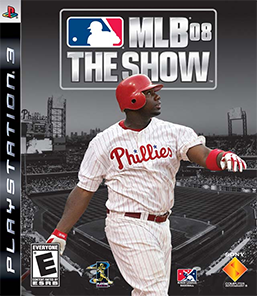
MLB 08: The Show is a baseball simulation video game developed by San Diego Studio published by Sony Computer Entertainment for the PlayStation 2, PlayStation 3, and PlayStation Portable systems. It is the longest-running officially licensed Major League Baseball game series on the PlayStation systems. MLB 08: The Show is the third edition of the MLB: The Show series of video games. The game was announced for all three PlayStation consoles on December 11, 2007, and released on March 4, 2008 in North America. Ryan Howard, all-star first baseman for the Philadelphia Phillies, is featured as the game's cover athlete.

Madden NFL 10 is an American football video game based on the National Football League that was published by EA Sports and developed by EA Tiburon. The 21st installment of the Madden NFL series, it is the first game to feature two players on the cover: Troy Polamalu of the Pittsburgh Steelers and Larry Fitzgerald of the Arizona Cardinals, who played against each other the previous season in Super Bowl XLIII. It was released in August 2009 for the PlayStation 2, PlayStation 3, PlayStation Portable, Wii, Xbox 360 and BlackBerry, and for the iOS on September 9 through the App Store.
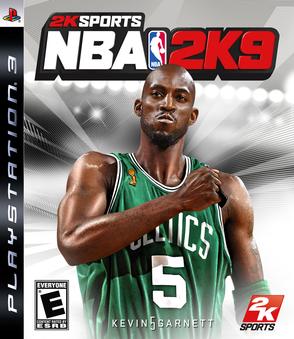
NBA 2K9 is a 2008 basketball simulation video game developed by Visual Concepts and published by 2K. It is the tenth installment in the NBA 2K franchise and the successor to NBA 2K8. It was released in 2008 for the PlayStation 2, PlayStation 3, Xbox 360, and Microsoft Windows. Kevin Garnett of the Boston Celtics is the cover athlete of the game. NBA 2K9 is the predecessor to NBA 2K10 in the NBA 2K series.

FIFA Soccer 96 is a football simulation video game developed by Extended Play Productions and released by Electronic Arts in 1995. It was released for the Mega Drive/Genesis, Sega Saturn, Sega 32X, Game Gear, PlayStation, Super Nintendo Entertainment System, and MS-DOS compatible operating systems.
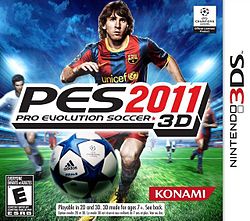
Pro Evolution Soccer 2011 3D is an association football video game released as a launch title for the Nintendo 3DS, developed and published by Konami. It is a re-release of Pro Evolution Soccer 2011, but in 3D and instead of the camera being in broadcast view, the camera is behind the currently selected player.

3D Baseball is a sports game developed and published by Crystal Dynamics and distributed by Mindscape. It was released in December 1996 for PlayStation and Sega Saturn. It features CNN sportscaster Van Earl Wright as the announcer.
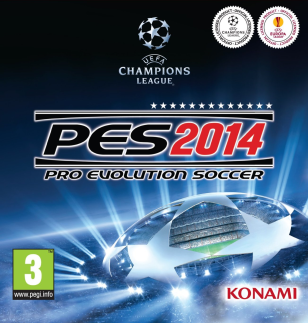
Pro Evolution Soccer 2014 is an association football video game developed and published by Konami for Microsoft Windows, Nintendo 3DS, PlayStation 2, PlayStation 3, PlayStation Portable, and Xbox 360 in 2013. The cover art for the game was the first in the series not to feature a football player since Pro Evolution Soccer 3 was released in 2003, although a later version was released with football players on the cover. PES 2014 was the last game to be released on the PlayStation 2 and PlayStation Portable in Europe. It was succeeded by Pro Evolution Soccer 2015.

Goal Storm, known as World Soccer: Winning Eleven in Japan, is a football sports video game developed by Konami Computer Entertainment Tokyo and published by Konami. It was released in late 1995 in North America and in early 1996 elsewhere for the PlayStation. It is the first installment of the Winning Eleven franchise, later known as Pro Evolution Soccer internationally. Gameplay-wise, the player controls one of thirty six national teams over two different game modes, which both simulate association football matches and/or tournaments.





















